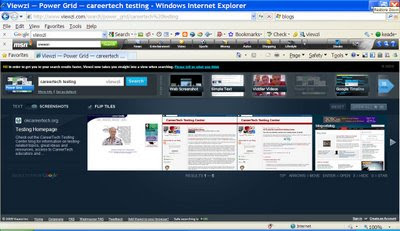
I thought I might offer a few suggestions for your students as they continue taking the various tests that are administered at the end of the academic year. The list is definitely not inclusive, but just some of my personal favorites:
Prior to taking a test: (provided by TestTakingTips.com)
Prior to taking a test: (provided by TestTakingTips.com)
1. Preparation for your first test should begin after the first day of class; this includes studying, completing homework assignments and reviewing study materials on a regular basis.
2. Budget your time, make sure you have sufficient time to study so that you are well prepared for the test.
3. Go to review, pay attention to hints that the instructor may give about the test. Take careful notes and ask questions about items you may be confused about.
4. Ask the instructor to specify the areas that will be emphasized on the test.
5. Make sure you go to the class right before the test; it's another prime time for the instructor to give out more hints or the format of the test.
6. Go over any material from practice tests, HW's, sample problems, review material, the textbook, class notes...
7. Eat before a test, having food in your stomach will give you energy and help you focus, but avoid heavy foods which can make you groggy.
8. Don't try to pull an all nighter, get at least 3 hours of sleep before the test.
9. Put the main ideas/information/formulas onto a sheet that can be quickly reviewed many times, this makes it easier to retain the key concepts that will be on the test.
10. Try to show up at least 5 minutes before the test will start.
11. Set your alarm and have a backup alarm set as well.
12. Go to the bathroom before walking into the exam room, you don't want to waste anytime worrying about your bodily needs during the test.
2. Budget your time, make sure you have sufficient time to study so that you are well prepared for the test.
3. Go to review, pay attention to hints that the instructor may give about the test. Take careful notes and ask questions about items you may be confused about.
4. Ask the instructor to specify the areas that will be emphasized on the test.
5. Make sure you go to the class right before the test; it's another prime time for the instructor to give out more hints or the format of the test.
6. Go over any material from practice tests, HW's, sample problems, review material, the textbook, class notes...
7. Eat before a test, having food in your stomach will give you energy and help you focus, but avoid heavy foods which can make you groggy.
8. Don't try to pull an all nighter, get at least 3 hours of sleep before the test.
9. Put the main ideas/information/formulas onto a sheet that can be quickly reviewed many times, this makes it easier to retain the key concepts that will be on the test.
10. Try to show up at least 5 minutes before the test will start.
11. Set your alarm and have a backup alarm set as well.
12. Go to the bathroom before walking into the exam room, you don't want to waste anytime worrying about your bodily needs during the test.
During the test: (provided by TestTakingTips.com)
1. Read the entire question before looking at any of the answers.
2. Formulate your thoughts. In other words, come up with the answer before looking at the possible answers.
3. Read all of the choices.
4. Eliminate answers you know aren't right.
5. Choose the correct answer.
6. If you aren't totally sure of the correct answer take an educated guess and select an answer.
7. Don't keep changing your answer. Your first choice is usually the right one (unless you miss-read the question).
8. In "All of the above" and "None of the above" choices, if you are certain one of the statements is true don't choose "None of the above" or one of the statements are false don't choose "All of the above".
9. In a question with an "All of the above" choice, if you see that at least two correct statements, then "All of the above" is probably the answer.
10. A positive choice is more likely to be true than a negative one.
11. If there is an "All of the above" option and you know that at least two of the choices are correct select the "All of the above" choice
12. Usually the correct answer is the choice with the most information.
13. Take the time to check all of your answers before handing in/submitting the test.
If you absolutely have no clue:
4. Eliminate answers you know aren't right.
5. Choose the correct answer.
6. If you aren't totally sure of the correct answer take an educated guess and select an answer.
7. Don't keep changing your answer. Your first choice is usually the right one (unless you miss-read the question).
8. In "All of the above" and "None of the above" choices, if you are certain one of the statements is true don't choose "None of the above" or one of the statements are false don't choose "All of the above".
9. In a question with an "All of the above" choice, if you see that at least two correct statements, then "All of the above" is probably the answer.
10. A positive choice is more likely to be true than a negative one.
11. If there is an "All of the above" option and you know that at least two of the choices are correct select the "All of the above" choice
12. Usually the correct answer is the choice with the most information.
13. Take the time to check all of your answers before handing in/submitting the test.
If you absolutely have no clue:
Try among the following recommendations offered by Dennis H. Congos, Certified Supplemental Instruction Trainer at the University of Central Florida:
1. Choose the most general answer when other choices are specific.
2. Choose the longest answer when others are much shorter.
3. Choose the answer with a middle value when other answers are higher or lower.
4. Choose neither of the similar answers.
5. Choose one of two opposite answers.
6. Choose the answer that agrees grammatically. (For ex: a, and an = singular, are = plural.)
7. Choose the answer most synonymous with key words in the question or statement.
8. Count the number of blanks in fill-in questions or statements.
9. Choose from among familiar answers. Avoid unknown options.
10. Choose the most logical answer to you.
11. Avoid answers with absolutes in them. (Examples are always, never, every, none, all, only.)











